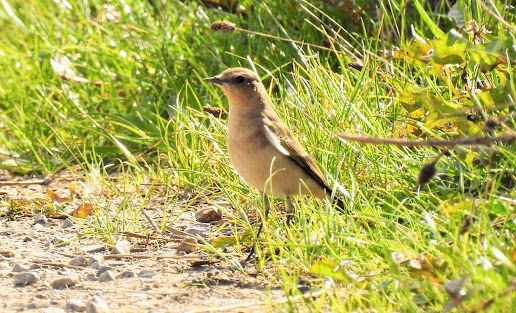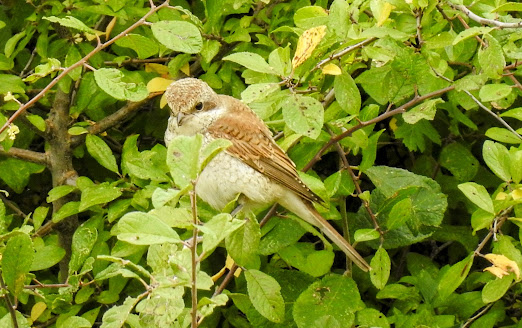Saturday 1st October 2022.
Last night's heavy rain and strong winds soon abated overnight and early this morning, the sky was clear blue and the temperature was quite mild. The outside egg trays were sodden yet still held a few moths, while the vast majority made it to the moth box, with a few on the white sheet.
Silver Y moth. My first of this species for a few weeks.
Large Yellow Underwings easily outnumbered all the other moth species and it was a nice return of both Silver Y and Rusty-dot Pearl added to my total this morning. 49 moths of 11 species were noted this morning. A Chiffchaff was heard calling again nearby, but nothing flew over the houses this morning. The moths recorded this morning included the following:
- 14 Large Yellow Underwing
- 6 Lesser Yellow Underwing
- 4 Lunar Underwing
- 7 Square-spot Rustic
- 2 L-album Wainscot
- 2 Angle Shades
- 1 Silver Y
- 1 Rusty-dot Pearl
- 3 Clepsis consimilana
- 8 Light Brown Apple Moth
- 1 Box Tree Moth
Over at ‘Cowplain Marsh’ (Andy’s house), there were a few moths to look at and the best of the bunch by a long way was my first Barred Sallow of the year, which was perched on his back door. Overhead, a pair of House Martins sailed high overhead and a few Meadow Pipits flew over, while nearby, both Great Spotted Woodpecker and Chiffchaff were heard calling. After last night's storm, I was hoping a Phalarope might have been found somewhere on the south coast. But none reported today although there was a possible Spotted Sandpiper seen on the Deeps on Farlington Marshes this morning, but not confirmed.
Not so many moths at Andy's house, but still a nice variety including the Barred Sallow.
The following moths were by Andy’s moth box:
- 1 Barred Sallow (NFY)
- 1 Shuttle-shaped Dart
- 1 Lunar Underwing
- 2 Large Yellow Underwing
- 2 Lesser Yellow Underwing
- 1 Square-spot Rustic
- 3 Eudonia angustea
- 1 Common Plume
For a welcome change, I decided to take a trip over to Thorney Island and it most certainly paid off. Though it was a bit breezy on the seawall, it was dry and sunny most of the time and there was also a lot to look at during our trip here. We gave both the west side and the fields to the east of Eames Farm a good look and some nice birds were picked up during the morning, which included a ‘year-tick’ and also 4 raptor species. The Brent Geese were back in good numbers within Emsworth Harbour and also a large number of Wigeon resting on the Little Deeps.
However, it all wasn't a total pleasure here as walking along the footpath leading to the seawall, we came across so much dog mess along the path, that it was most likely a health hazard. We really had to watch our step along here and concentrate on where to walk at times. Sadly, a lot of idiots let their dogs loose and are free to mess anywhere. Let's get back to the birds. It was very quiet along the path with not a great deal seen along here and when we reached the seawall, it was low tide within Emsworth Harbour. From here, we picked out a few waders that included Black-tailed Godwit, a single Bar-tailed Godwit, Oystercatcher, Turnstone, Redshank and Curlew. The arrival of a large flock of Brent Geese was noted, which all flew north up the harbour. Another flock was seen feeding in the harbour just off the seawall near the Great Deeps.
Resting for a while on the small bench overlooking the Little Deeps, I checked thoroughly the water for a Phalarope, but no diamonds. However, we did see a Water Rail flying over from one reedbed to another, which was a bonus. There was a large flock of Wigeon resting on the water and intermingled with these, Tufted Duck, Mallard and a few Little Grebes were picked out. A lone Pintail flew overhead, circled and then landed at the back of the Little Deeps. In the distance, both a female Marsh Harrier and a Common Buzzard were seen flying over the fields, while a few Skylarks ‘bubbled’ overhead.
The Great Deeps was busy, but nothing much of note, bar a Common Buzzard playing around with something in its talons (see film footage), which got the attention of a male Kestrel which was quickly dismissed. There must have been around 100+ Coot on the water on the Great Deeps and a few Wigeon among them too, but very little else of note. Again, not a great deal of note on the way back to the car, but we did pick out a male Blackcap deep within some brambles along the fouled-up path leading to the car park.
I wanted to try my luck from the side of the road at Eames Farm, overlooking the fields and the Great Deeps and so got back into the car and parked up by the Farm. From here, a birder who was just about to leave the site told us that both Marsh Harrier and Osprey were present and so we made our way to the fence gate. Both species were, thankfully, still present, although we had to wait for about 30 minutes for the Osprey, a female bird, to show. Before then, a Great White Egret was seen to our right, feeding in the Great Deeps near the main road until it flew off and joined a second bird over on the east side of the island, along with roughly ten Little Egrets and about 4 Grey Herons.
Two Marsh Harriers were seen quartering the fields, although both remained quite distant. A Common Buzzard was also present, resting on the ground near the main lake and a pair of Ravens showed very well at times out in the fields. They even gave one of the Marsh Harriers a tough time. The Osprey eventually flew in, first seen flying very low over the ground and then landing near the Great Deeps, with the Landing Lights in the background. Bird of the day had to go down to the Jack Snipe which was totally unexpected (some of the best ones normally are!) as I picked it out flying over the fields heading north. Its very small bill and diminutive size immediately had me carefully making sure it was an actual Jack Snipe, especially after the fiasco I had earlier this year at Titchfield Haven. My 213th species for the year, which rounded our trip here off very nicely.
To finish off our day together, a beer and some lunch at The Chairmaker's Arms in Denmead was our next destination. I just had the one Cider for me and some nosh within the Pub garden, where we could watch some of the bird life. A Red Kite greeted us as we arrived in the car park and two more were seen a little later over the woods. A large mixed flock of both Goldfinch and Linnet rested on the overhead wires near the paddocks and a pair of Mistle Thrushes were seen flying over the fields. No rare butterflies like the last time we were here, but a Red Admiral and a Large White butterfly was noted. Andy enjoyed his FOUR pints while I had a coffee!








































































